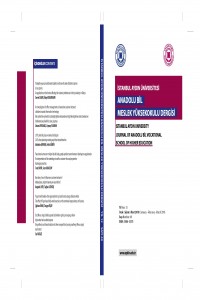Abstract
The marketers can assess and examine the influences of branding on
customers so that they can develop convincing brand messages to target
the right customer using the right message. Branding is developing into
one of the most successful tactics of marketing teams in recent times;
so much that it has almost become a prioritized area of study for future
marketers. This was the main rationale behind conducting this research
to understand how branding influences the customer psyche and purchase
inclinations so that marketers exert more efforts towards branding as a
constant activity for increased brand equity and enhanced company image.
A survey was used in this research. The questionnaire which includes a
total of 19 questions was submitted by 200 customers. Data were analyzed
using SPSS.
Keywords
References
- [1] Aaker, D.A., (2011). Building brand relevance”, John Boss, San Francisco.
- [2] Allender, W.J. & Richards, T.J., (2012). Brand loyalty and price promotion strategies: an empirical Analysis. Journal of Retailing 88(3), 323–342.
- [3] Keller, K.L., (2008), “Strategic brand management: building, measuring and managing brand equity”, 3rd edition, Pearson Prentice Hall, New Jersey.
- [4] Keller, K. L. (2003). Brand synthesis: The multidimensionality of brand knowledge. Journal of Consumer Research, 29(4), 595- 600.
- [5] Marken G.A, (2003). Emotional Branding, How Successful Brands the Irrational Edge, Public Relations Quarterly, Vol. 48, Issue2, 12-25.
- [6] Morschett, D., (2001). Retail Branding As a Goal of Strategic Retail Marketing-a Causal Model From the Perspective of Consumer Research. European Advances in Consumer Research, 5, 107-110.
- [9] Mullen, B., Johnson, C., (2013). The Psychology of Consumer Behavior. Psychology Press. New Jersey.
- [10] Hopkins, Ed., (2007). Adaptive Learning Models of Consumer Behavior. Journal of Economic Behavior and Organization, Vol-64, 348-368.
- [11] Okafor, A.I. (1995). Principles of Marketing, the Atomic Approach. Onitsha: Baset Printing Limited
- [12] Petromilli, M., Morrison, D. & Million, M.., (2002). Brand architecture: Building brand portfolio value. Strategy and Leadership Journal, 30(5), 22–28.
- [13] Stephens, S., Townsend., (2007). Choice as an Act of Meaning: The Case of Social Class. Journal of Personality and Social Psychology, Vol. 93, Issue 5, 814-823.
- [14] Zaltman, G., (2003). How Customers Think: Essential Insights into the Mind of the Market, Harvard University Press, Cambridge.
- [15] Zhang, Y., (2015). The Impact of Brand Image on Consumer Behavior: A Literature Review, Journal of Business and Management, 3, 58-62.
- [16] Zhang, Y. (2015). The Impact of Brand Image on Consumer Behavior: A Literature Review. Journal of Business and Management, 3, 58-62.
Abstract
References
- [1] Aaker, D.A., (2011). Building brand relevance”, John Boss, San Francisco.
- [2] Allender, W.J. & Richards, T.J., (2012). Brand loyalty and price promotion strategies: an empirical Analysis. Journal of Retailing 88(3), 323–342.
- [3] Keller, K.L., (2008), “Strategic brand management: building, measuring and managing brand equity”, 3rd edition, Pearson Prentice Hall, New Jersey.
- [4] Keller, K. L. (2003). Brand synthesis: The multidimensionality of brand knowledge. Journal of Consumer Research, 29(4), 595- 600.
- [5] Marken G.A, (2003). Emotional Branding, How Successful Brands the Irrational Edge, Public Relations Quarterly, Vol. 48, Issue2, 12-25.
- [6] Morschett, D., (2001). Retail Branding As a Goal of Strategic Retail Marketing-a Causal Model From the Perspective of Consumer Research. European Advances in Consumer Research, 5, 107-110.
- [9] Mullen, B., Johnson, C., (2013). The Psychology of Consumer Behavior. Psychology Press. New Jersey.
- [10] Hopkins, Ed., (2007). Adaptive Learning Models of Consumer Behavior. Journal of Economic Behavior and Organization, Vol-64, 348-368.
- [11] Okafor, A.I. (1995). Principles of Marketing, the Atomic Approach. Onitsha: Baset Printing Limited
- [12] Petromilli, M., Morrison, D. & Million, M.., (2002). Brand architecture: Building brand portfolio value. Strategy and Leadership Journal, 30(5), 22–28.
- [13] Stephens, S., Townsend., (2007). Choice as an Act of Meaning: The Case of Social Class. Journal of Personality and Social Psychology, Vol. 93, Issue 5, 814-823.
- [14] Zaltman, G., (2003). How Customers Think: Essential Insights into the Mind of the Market, Harvard University Press, Cambridge.
- [15] Zhang, Y., (2015). The Impact of Brand Image on Consumer Behavior: A Literature Review, Journal of Business and Management, 3, 58-62.
- [16] Zhang, Y. (2015). The Impact of Brand Image on Consumer Behavior: A Literature Review. Journal of Business and Management, 3, 58-62.
Details
| Primary Language | English |
|---|---|
| Journal Section | Articles |
| Authors | |
| Publication Date | March 31, 2018 |
| Submission Date | July 1, 2016 |
| Published in Issue | Year 2018 Volume: 13 Issue: 49 |


